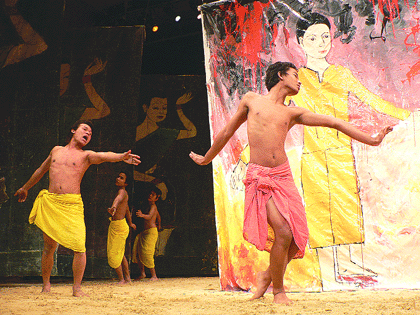Somber, soulful, and measured “Cambodian Stories”
Eiko & Koma have collaborated with many artists, but for the most part they are known as a self-contained unit, genre-wise and in performance. But in “Cambodian Stories” at Asia Society, they shared the sand-covered stage with a group of nine young painting students who danced to arrest time, and in contrast, turned the act of mural painting into a race against time. It was genuinely stirring to see Eiko & Koma—ageless in appearance, both in their 50s—tenderly guiding their young cohorts from the Reyum Painting Collective in Phnom Penh.
The evening began with each student reciting a short biography, ending with some variant on “I want to be an artist.” The curtain dropped, revealing forest green flats painted with female figures, and a blank, white canvas lying center stage, over which a horizontal log scaffolding was placed. The young men, in bright yellow saris, clutched containers of paint and hung like sloths on the logs, or expertly hopped from one to another, balancing momentarily to dab at the canvas below. After just 10 minutes, the painting was fleshed out enough to depict a female whose gold two-piece dress resembled that of Chakreya So, the only female student.
She and Setpheap Sorn, in a pink sari, were featured dancers. Sorn seemed particularly well-suited for the stage—he is strikingly beautiful, with thin, long limbs and a noble detachment. So’s bangs flopped over her eyes, adding a level of opacity, but she infused the movement—a slow sideways shuffle, head pinned to one shoulder, outstretched arms bearing gnarled hands—with a profound soulfulness. Both were remarkably affectless and unselfconscious, particularly at 16 and 17 years of age, and given that Eiko & Koma’s trancelike, seamless choreography is almost perversely unsuited to the temperament of youth. The other Reyum performers looked less spiritually disembodied than ruminative; all were highly focused and clearly well-disciplined.
Music director Sam-Ang Sam selected the music, including a handful of Cambodian pop songs in addition to traditional flute and string sections. The cheery, blunt simplicity of many of the pop tunes proved a jarring contrast to the somber tone and considered movement, and was the weakest element of the production. The cast, led by Eiko and Koma—who wore a red silk jacket, later changing into an austere robe—formed a chain by linking hands and slowly snaking across the stage, lip synching the words in Cambodian to “Take Me to Your Heart,” like a surreal karaoke session.
“Cambodian Stories” neither dwelled on nor glossed over the terrible past few decades in that nation. Collapse was implied when the painted flats shook and fell to the ground, exposing a fragile support system of pulleys and ropes. In a parallel event, So crumpled to the ground, and her body was placed on a mound of dirt. The Reyum team brought on a vertical scaffold in order to paint a mural on the glossy black backdrop. A mountain range took shape, only to transform into a woman arching out of the sea—perhaps the spirit of So, rising, emblematic of the resilience of the Cambodian people. She, Eiko, and Koma struggled to crawl without limbs, bodies thudding ponderously, breath expelling loudly with each drop of the shoulder.
The brutal Khmer Rouge regime held power three decades ago, and yet a tribunal is still only now being organized. So as much as we’d like to think that Cambodians have moved on, there has been no formal justice yet. “Cambodian Stories” contributes what it can toward grieving and healing. In the finale, the young men faced upstage, their still, bare backs morphing into an abstract field of headless bodies. All faced us and kneeled, hands held palm to palm over the heart and bowed their heads in a simple prayer, once forbidden by the Khmer Rouge.
gaycitynews.com


































